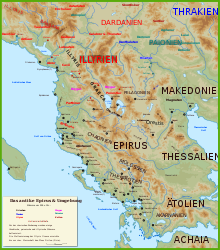Chaonier
The Chaonians ( ancient Greek Χάονες ; Latin Chaones ) were one of the three great Greek tribes of Epirus that made up the population of Epirus in ancient times . They lived in the Chaonia landscape , named after them , which is located opposite the island of Corfu on the coast of the Ionian Sea today partly in Albania and partly in Greece. In the southeast the area of the Chaonians bordered on that of the Molossians and in the south on the Thesproters .
The main places of the Chaonians were Buthroton ( Butrint ), Phoinike and Ilium . In the 5th century BC The Chaonians found themselves in constant disputes with the Greeks of Corfu. The latter managed to establish themselves on the coast and dominate Butrint and some other permanent places in the Chaonian territory. In 429 BC Chr. The chaonians were in the Battle of Stratos by Acarnanians defeated. At this time they apparently already lived in an aristocratic republic (compare Thucydides II, 80).
Chaonians lived alongside other tribes in the southern half of southern Italy. The landscape between Croton and Siris is named after them Chonia . Whether at all and if so, which relationships existed between the tribes of the same name on both sides of the sea cannot be proven on the basis of the sparse historical sources.
The Epirotic Chaonians were members of the Epiroten League for a long time (middle of the 4th century until 231 BC) and were associated with the kingdom of the Molossians. After the abolition of the kingship in Epirus they belonged to the republican Koinon of the Epiroten. Immediately before the outbreak of the Third Macedonian War (172–168 BC), the Epiroten were called to support Rome, which split the covenant. While the Molossians stood by the Macedonians, the Thesproters and Chaonians sided with the Romans under the prince (or hegemon) Charops. After the end of the war, the Chaonians, like the rest of the Epiroten, remained under Roman rule. 148 BC Its area was integrated into the Roman province of Macedonia.
Individual evidence
- ^ John Boardman, Nicholas Geoffrey Lemprière Hammond: The Cambridge Ancient History - The Expansion of the Greek World, Eighth to Sixth Centuries BC Ed .: Cambridge University Press. Second ed. Volume 3 . Cambridge, United Kingdom 1982, ISBN 0-521-23447-6 , pp. 284 ( online version [accessed May 5, 2015]).
- ↑ David Malcolm Lewis, John Boardman: The Cambridge Ancient History: The Fourth Century BC Ed .: Cambridge University Press. Cambridge, United Kingdom 1994, ISBN 0-521-23348-8 , pp. 430,434 ( online version [accessed May 5, 2015]).
- ↑ John Wilkes: The Illyrians . Ed .: Blackwell Publishers Limited. Oxford, United Kingdom 1995, ISBN 0-631-19807-5 , pp. 401 ( online version [accessed May 5, 2015]).
- ↑ Edgar Hösch, Karl Nehring, Holm Sundhaussen (ed.): Lexicon for the history of Southeast Europe . Böhlau, Vienna / Cologne / Weimar 2004, p. 216 ( online version [accessed May 5, 2015]).
- ^ Karl Kaser: Shepherds, Fighters, Tribal Heroes: Origins and Presence of the Balkan Patriarchate . Böhlau, Vienna / Cologne / Weimar 1992, p. 39 ( online version [accessed May 5, 2015]).
